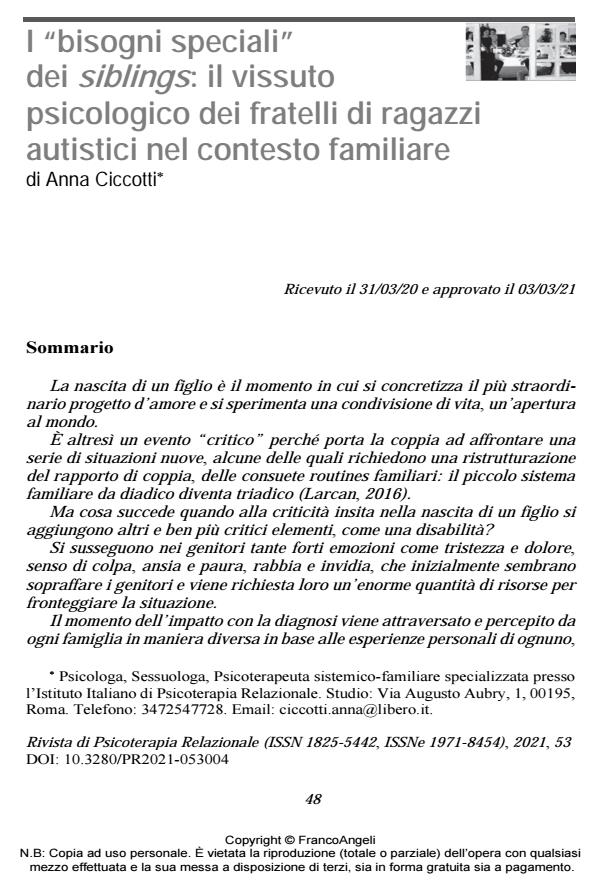The "special needs" of siblings: the psychological experience of siblings of autistic children in the family context
Journal title RIVISTA DI PSICOTERAPIA RELAZIONALE
Author/s Anna Ciccotti
Publishing Year 2021 Issue 2021/53
Language Italian Pages 27 P. 48-74 File size 253 KB
DOI 10.3280/PR2021-053004
DOI is like a bar code for intellectual property: to have more infomation
click here
Below, you can see the article first page
If you want to buy this article in PDF format, you can do it, following the instructions to buy download credits

FrancoAngeli is member of Publishers International Linking Association, Inc (PILA), a not-for-profit association which run the CrossRef service enabling links to and from online scholarly content.
The birth of a baby is the moment in which the most extraordinary love project takes shape, and a sharing of life and an opening to the world is experienced. Nonetheless, it is also a "critical" event because it leads the couple to face a series of new situations, some of which require the restructur-ing of the couple’s relationship and the usual family routines: in fact, the small dyadic family system becomes triadic (Larcan, 2016). What happens, however, when other and much more critical ele-ments - such as a disability - are added to the inherent criticality of the birth of a child? Parents experience many strong emotions, such as sadness and pain, guilt, anxiety and fear, anger and envy, which initially seem to overwhelm them. A huge amount of resources to deal with the situation is required. Each family perceives and goes through the tough time of the diag-nosis in a different way, based on each one’s personal experiences, social values and cultural background, but also based on the manner the diagnosis is made, the accessibility to adequate family support, and the availability of information. Finally, a significant weight is represented by the possibility of ben-efitting from adequate social support, which is both health and psycho-logical support services for both the child and the family (Cuzzocrea, Larcan, 2011). It has not been long since literature began to investigate a very in-teresting and complex issue concerning the "healthy" brothers and sisters of children with physical or mental problems. This line of research has been dedicated to the study of the so-called siblings, a term that, while in the Anglo- Saxon world simply indicates a bond of fraternity, in the Italian panorama refers specifically to brothers and sisters of children with disabilities. If taking care of children is a natural process for parents, which can become more difficult because of the child’s ailment, it is not so obvious for a sibling to think they have to bear the pathology and life of their loved one once their parents are gone. The autistics’ siblings often look alike: they are silent, deep, dream-er and suspicious; it is difficult for them to adapt to the way their peers live, joke, and behave. This work takes into consideration the emotional world - often still little explored - of those who live as the "brother (or sister) of throughout their lives, analyzing the consequences of the presence of the child with autism on the life of their sibling with typical develop-ment.
Keywords: Siblings, Autism, Children with "special needs", "Invisi-ble" children.
Anna Ciccotti, I "bisogni speciali" dei siblings: il vissuto psicologico dei fratelli di ragazzi autistici nel contesto familiare in "RIVISTA DI PSICOTERAPIA RELAZIONALE " 53/2021, pp 48-74, DOI: 10.3280/PR2021-053004